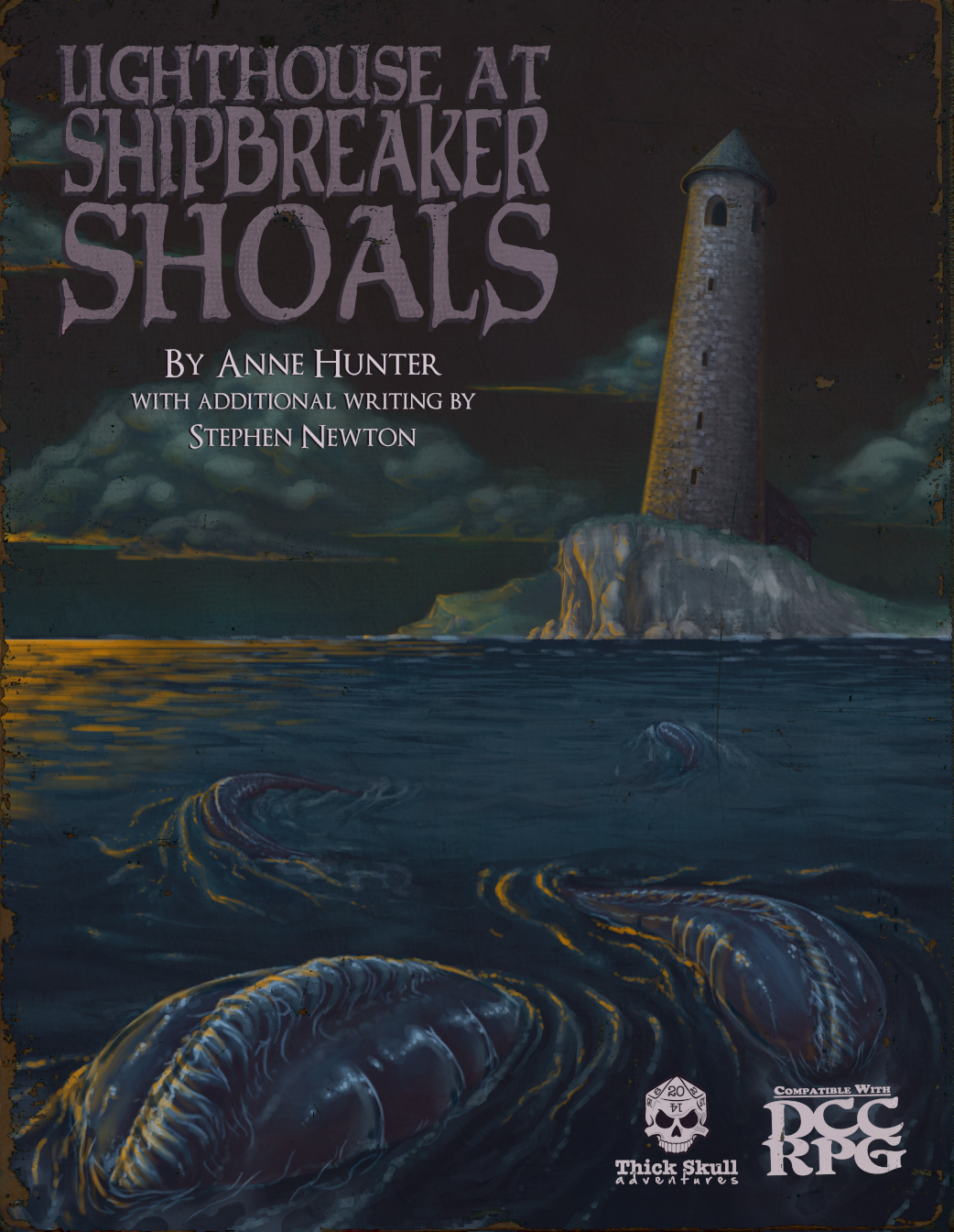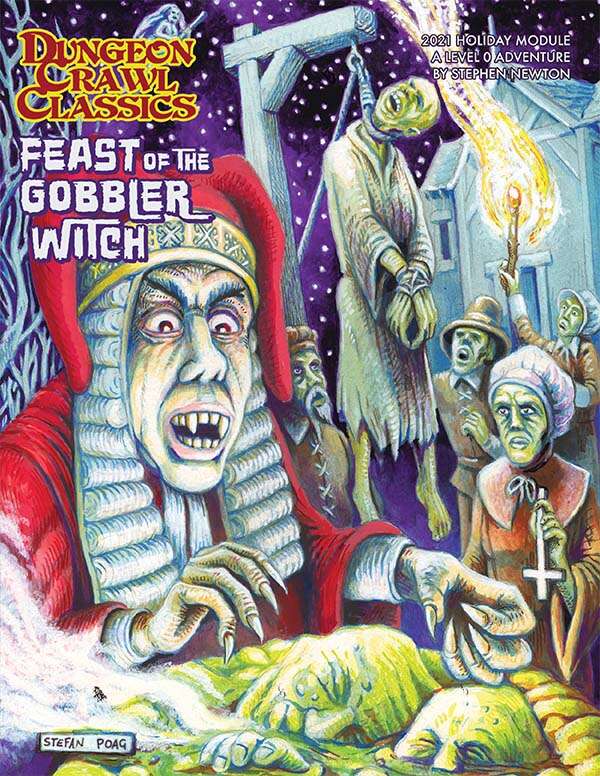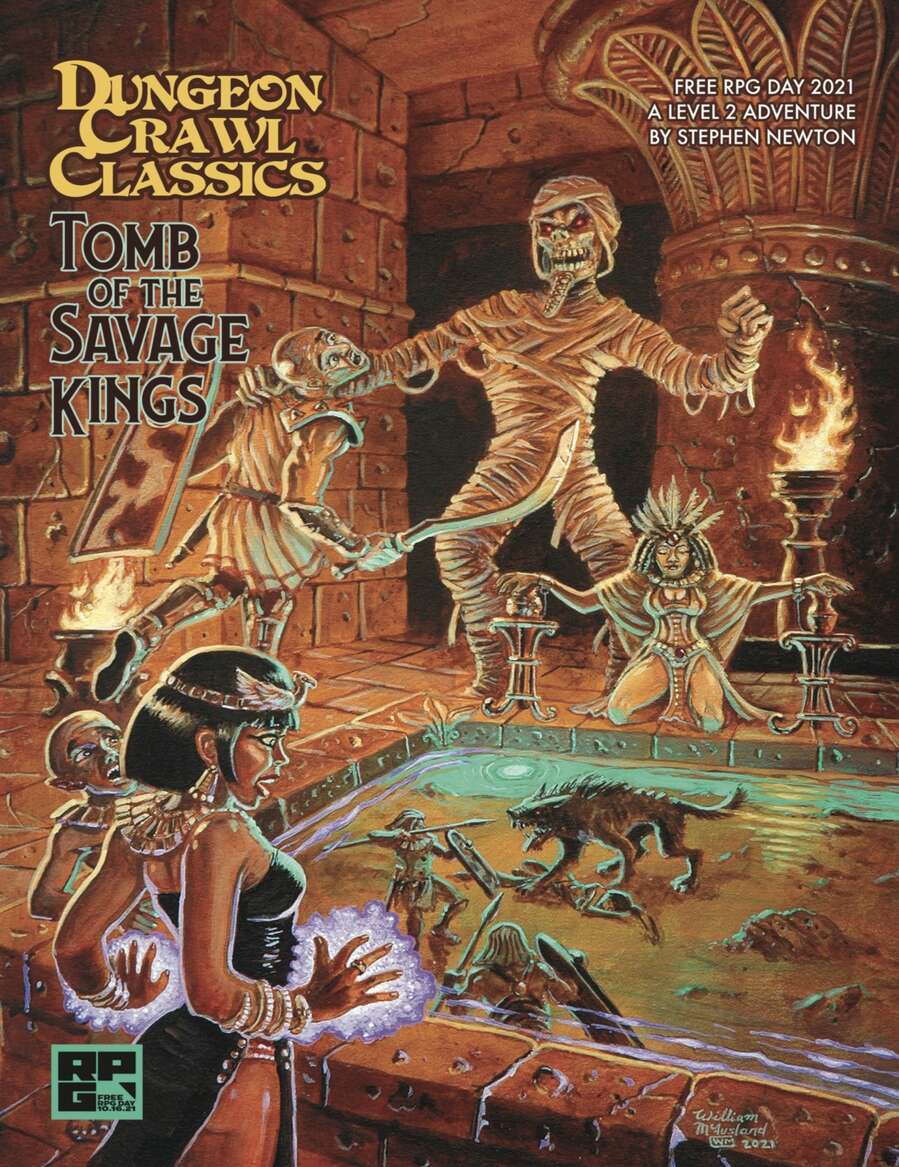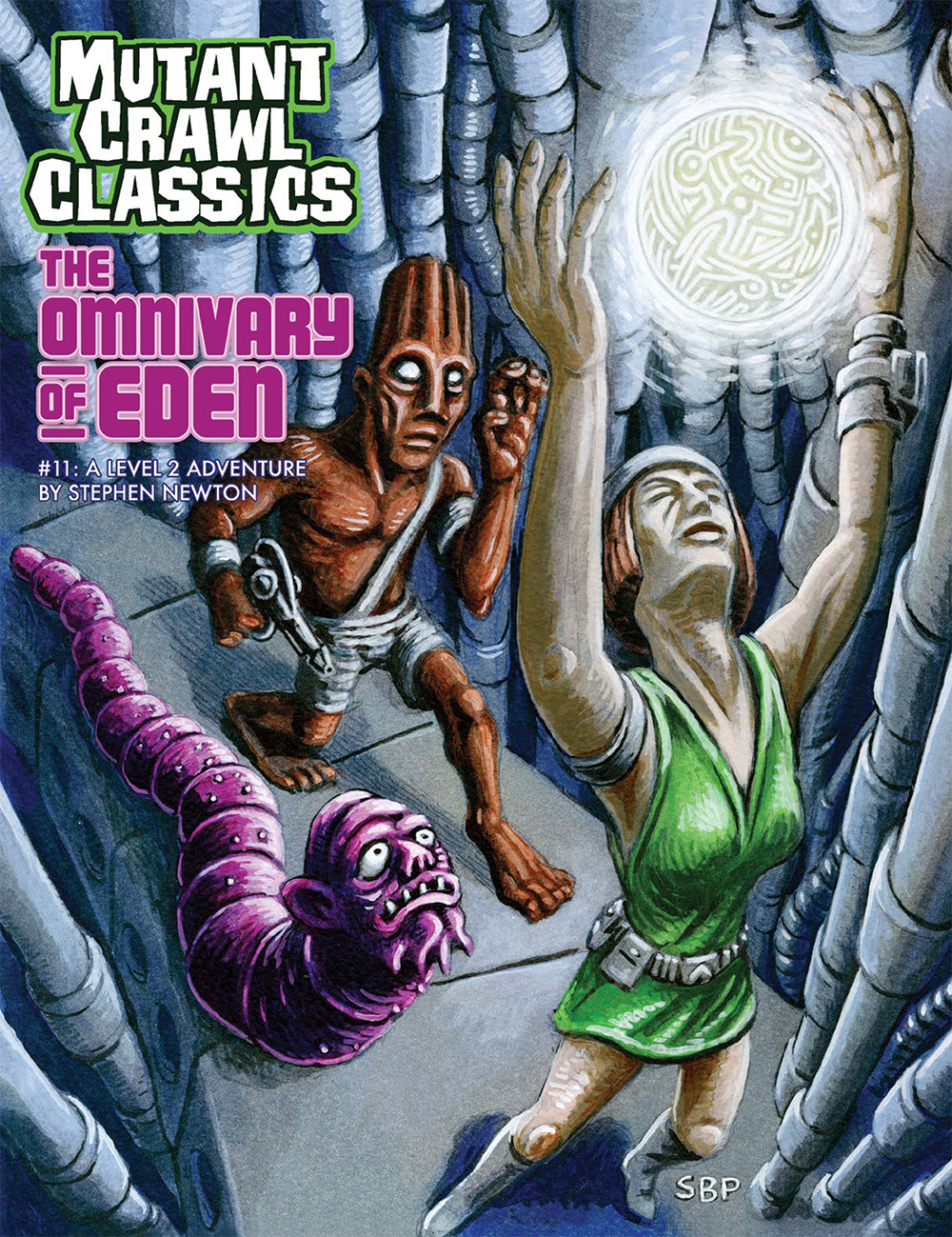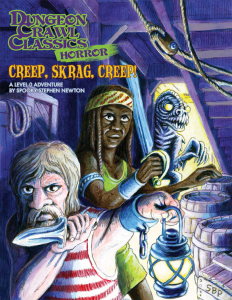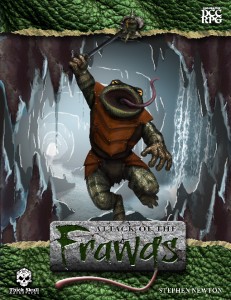One of the blog readers (Keith M. of Dragon Claw Adventures @DragonClawAdven) had sent me an email asking me several questions related to my experiences with writing my first adventures and if there was any tips I could pass on. As I believe in karma (not really, but I do believe in kindness) and I was in the same spot and given similar advice by Guy Fullerton of Chaotic Henchmen Productions about 2 years ago I thought I would do the same and publish my experiences here. Keith said that this type of info might be valuable to others–and I certainly acknowledge that Guy’s information was valuable to me–so here it is. (PS: I see that Guy is now updating his website with similar valuable information so I suggest you guys go check that out as well!)
I’m basically just re-printing the answers I gave to Keith based on the q’s he asked. Here it goes.
The old-school feel of Frawgs, DCC RPG and D&D 4E:
The old-school feel of my adventures do not happen by accident. The bulk of my gaming was done using AD&D. When I first started writing Haunting of Larvik Island (aka “Larvik 1”) I had inteded to potentially publish as an OSRIC module, but was advised a the time that 4E may be the way to go. That added another 8 months to the project as I got comfortable with the ruleset and in the end didn’t help me that much for by the time I actually published Larvik 1 the “Edition Wars” were in full swing. The module didn’t do as well as I hoped despite getting many good reviews. When DCC RPG was announced I immediately was interested. I wrote about that experience here.
So you’ve decided to self publish:
Good for you, aspiring author! And you’re doing all the right things [writing several drafts, getting several proofreaders to edit your work]. The other thing I would recommend is trying to get some folks outside your friendlies to proofread, and if possible, have someone else DM it for you. I write about getting outside DM’s and playtesters here.
Will I Break Even or Make Any Money From My Adventure?
Depends on what you mean by “break even” & making money. The short answer is: probably not, but depends on what expenses you’re including. With Larvik 1 I sold about 35 print copies and a few more than that in PDF (about 38 if memory serves.) You make less margin on print (approx 20% of cover price) and if you’re going RPGNow/DriveThru you’ll make about 60% of the PDF sale. PDF’s obviously return higher margins.
With Attack of the Frawgs I’ve done much better than I expected! As of this writing sold about 100 PDF copies. I would love to attribute this to now having an established audience and my great writing, but I believe the real answer is in the popularity of DCC RPG! There seems to be a lot of interest and so my timing was good. The royalties from PDF sales have actually funded the print run of the adventure. The print version of the module goes on sale at the end of Aug 2012.
If you add up the amount of cash I’ve spent in software, printing costs, and the money I pay Cat, I have made no profit. But, I didn’t start this hobby to make money I did it for love of writing and gaming, so that is OK by me. If you add my “labor” and if I actually start paying my artists there’s no way.
Finding Artists:
I’ve been lucky and have artist friends who were willing to contribute their art to my project out of their friendship to me and similar motivations of mine to just have their work out there in public. If you don’t have artist friends then you can checkout rpgfreelancer.com, or go to RPGNow.com and check out some of the stock art offerings. I’ve been VERY luck to have artists friends with similar motivations to my own.
Publishing for Print or PDF:
Figure out early on where you’re going to publish. Are you going to just do .pdf or are you going to do print as well. Laying out for print is a different game. Try to get a several quotes when the time comes. This will also determine which RPGNow royalty rate you can choose (e.g., you get larger royalties if you only publish through them.)
What Steps Did You Take When You Wrote The Module?
Here’s the steps I go through, sometimes you have to shortcut:
- Write the outline for the adventure. Check the number of encounters, the locations. Are there a good balance of traps, encounters, baddies? If you’re an overthinker like me, you write up motivations for each of the characters (but the modules I’m writing are hopefully going to be all played together in an epic sweep, so that’s probably not as important if you’re doing a standalone)
- Write the damn thing in Word or whatever you’re favorite word processor is. Don’t worry about formatting at this point at all. You’ll just get distracted. Keep word length in mind though. Depending on art, maps & whitespace and licensing and what not, the pages can add up quick. Frawgs was 7K words and took 12 pages (there were a couple pages of maps, licensing, ToC and an ad for Larvik1-DCC). Larvik 1 was 20K words and took up 44 pages. Most of the published modules out there from are about 10K words. Draw your maps by hand at this point.
- Send it out to a few friends for editing and proofreading. Send it out again. Print it. Read it again. Keep proofreading. Do it again, there’s still errors.
- Run it yourself, preferably with at least 2 different groups of gaming friends.
- If you can, have other people playtest it. Send it out. Get their feedback. HEED their feedback. That’s why you sent it out. With Larvik1 I was very lucky and actually recruited a DM at my FLGS to run the game with 4 of his friends and I just sat in the background and watched and took notes. It was a FABULOUS experience to watch someone else interpret the module. HEED the notes. Tweak the adventure where it doesn’t make sense, I had awkward spots, encounters or traps didn’t work as expected. I sent this draft of Frawgs to Joseph Goodman for his feedback as well. He’s very responsive to his licensees so take advantage if you can!
- Do a first pass of the layout in your publishing software. Here’s where I WOULD suggest spending some real money, the presentation can make all the difference. If you’re not a graphic designer by trade (I’m looking at your Jon Marr and you’re fabulous looking Purple Sorcerer game modules!) then try to hire out a Graphic Designer. I’m good friends with Catherine Harkins–and Cat is fabulous–so I get her at her best rate. It’s her skills that take my module from looking like a school paper to Fabulous Production Product. Anyway, put in the text, and then put in placeholders where you’re going to put maps and art. Figure out which scenes you’re going to want art for and start working on artists on what they’ll draw. With Larvik1 I wanted “handouts” similar to Tomb of Horrors. With Frawgs I wanted handouts as well but I didn’t have access to my free artist anymore 🙁 I’m going to see if I can get him back for Larvik 2 or maybe actually pay some artists. I go to ComicCon every year and pickup biz cards from artists so I may have some fresh blood, or I’ll do the rpgfreelancer.com steps like I suggested above 🙂
- Start drawing your maps For Real. Get a cartographer if you can (I could not, but I may with Larvik2). I know other 3PP have used rpgfreelancer.com or some cartography boards to get some great looking maps. I bought Campaign Cartographer 3 and used this to create the maps with Larvik1 and Frawgs. See lessons learned on maps…
- With Larvik 1, while I was writing and proofreading I simultaneously started working on my “external presence.” I setup a Twitter account and started following a gamers. I setup a website with some “coming soon” and putting up the blog. I started checking out the blogs (RPGNow, Enworld, etc.) to see what people were saying about other modules about what they liked and didn’t like. Create a Facebook page for your work as well. Create a Google Plus page (I have a personal G+ page but haven’t created a site yet for TSA. I will soon.)
- By this point your module should be well written, playtested and laid out. Now you do all your graphic design and layout. Depending on your skills this can be a long process as well. I typically do a first pass using Adobe InDesign myself and then I give it to Cat. She does the real magic with InDesign. Once it comes back from her then I…
- Start scrubbing for typos all over again. It’s amazing how many typos there are (not Cat’s fault, mine!) and you’ll still never catch them all. Send this draft (your layout draft) out to all the same folks and some new ones. The 3PP community on DCC RPG is wonderful for this. I’m editing Jon Marr’s latest as we speak, and they’ve all done the same for me. Note: this is also the version you’re going to send to Joseph Goodman for approval as you’re now getting very close to publishing.
- Be sure you do one more edit on the “Special Thanks” of all the folks who helped you playtest, gave advice, proofread, was helpful at your FLGS, etc.
- Start getting those printer quotes.
- Start working with a distributor if you’re going the print route. I can spend more time in a separate post about this.
- Setup your RPGNow.com account. This takes a while (couple of days) and you’re now itching to publish so best to get this out of the way early.
- I’m assuming you’re at least releasing as PDF (and potentially as print). Release with much fanfare! Announce on the DCC RPG boards, on the blogs you’ve been following, on the Facebook page, on your G+. Use lots of tags (DCCRPG, RPG, D&D, etc.) as some people have lists setup for searching tags.
- If you can, start going to some cons to promote. I personally haven’t had the chance to do this yet (darn real life) but from other publishers I’ve talked when I’ve asked them the same set of questions this is a good step to get the word out. Try to run your game at a con. I worked with my FLGS–the fabulous Game Kastle in Santa Clara, CA– to help get some in-store promotion.
- Get in tight with some people that run blog sites. Read their pages, comment on the reviews they do, promote their sites, for now you’re going to ask them to do the same for you. Most of them are really good folks who love games and love to promote new artists (I’m thinking of sites like Tenkar’s Tavern, GamingTonic, Game Knight Reviews, etc.). Contact all these folks and ask them if they’d like a review copy and then comp one for them. Thank them for their time once the reviews start appearing. Link to their sites, retweet their reviews, etc.
- This is the point where I’d return the question, dear readers, where did you hear about Attack of the Frawgs? I’m assuming it was from DCC RPG forum, but would be interesting to know which marketing worked?
- Send comp copies of the final published product to all the folks who helped you along the way. It’s the right thing to do.
- Anxiously await for that first sale to come in from someone who is not your friend or mom. When it does: Sit back in your smoking jacket, lift and scotch, a congratulate yourself that you’re now a published author 🙂
Lessons Learned, or What did I do differently on Frawgs after doing Larvik 1:
- Don’t worry about formatting of the Word draft. I did a bunch of fancy styling, two-column layout, monster block formatting, etc. Much of this changed once I got to InDesign or was unusable. Have it readable but don’t worry about format.
- Figure out if you’re going to print: if so, start thinking B&W vs. color with your art & graphs. I drew all my maps in color on Larvik1 and then when I started doing the B&W layout for print they looked like crap. I had to do a lot of re-work to fix and they still don’t look as good as I wanted. With Frawgs I designed the art & maps from scratch in B&W (Campaign Cartographer had an add-in of B&W templates that I used for the main maps.) I also had Cat do work beautifying the maps and add some elements that I could not draw (she did some of the custom drawing within the wheelhouse map, and touched up the lake map with some beautifying elements. She really is all kinds of awesome and well deservedly the Other Half of Thick Skull Adventures.)
- I had a broader base of reviewers to work with to help me get the word out with Frawgs. if I’d started earlier with these game sites, I could’ve used them earlier on with Larvik 1.
- Set your expectations: the bulk of the sales come in the first month after release. I know this now.
What To Do Next
- Stay engaged with the community. Due to some personal stuff I had to “go underground” this year and couldn’t stay as engaged on the boards as I would’ve liked. Real life has a way of doing that. Still, these guys are very important and they do a lot of good work on your behalf so stay in the picture.
- Do regular google searches for mentions of your product. There will be people out there reviewing and posting about your work once it’s published. Interact on their blogs and thank them for their time and input. This won’t help much on the first module, but they can obviously help get the word out when Module 2 appears.
- Support the community. Use your royalties/allowance to buy the other 3pp modules out there. We all have to support each other.
I hope this material helps anyone out there looking to getting into publishing!

